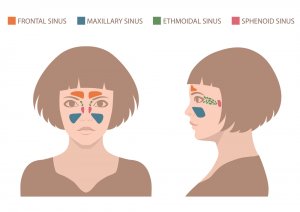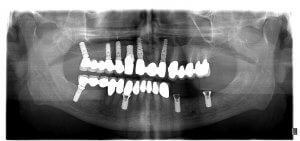Being told you need a sinus lift before getting tooth implants may seem daunting, but there is no need to worry. It’s a relatively common restorative surgical procedure that can make it possible for you to have implants even after suffering bone loss.
Here you can read all about what a sinus lift for implants involves, what sinus surgery costs in the US, and what to expect afterward. Don’t miss our tips for reducing the cost of the procedure – it’s possible to save hundreds if you know how!
What is a sinus lift?
It’s a surgical procedure which grafts bone to the upper jaw at the position of the molar and premolar teeth. The maxillary sinus membrane is lifted upwards to make space for the additional bone.
The sinus system has several parts but it’s the maxillary sinuses which sit closest to our teeth. You might sometimes get a toothache when you have congestion or a bad cold – this is because the pressure on the sinuses transfers to the tooth roots in the upper jaw.
The technical name for this procedure is a “maxillary sinus floor augmentation”, but you may also hear the terms “sinus augmentation” and “sinus graft” used. A specially-trained dental clinician, periodontist or oral surgeon carries out the surgery.
Why might you need the sinus lift procedure?
A sinus augmentation is performed when a patient has insufficient bone in their upper jaw to support a dental implant. Dental implants fuse with the jaw bone in a process called osseointegration. But this relies on there being a certain amount of bone present.


You may need sinus lift surgery before getting implants if:
- your jaw bone has previously been damaged, for example from trauma or a difficult extraction;
- a cyst or tumor has been removed from the area;
- you have suffered bone loss as a result of periodontitis;
- your bone has receded because of tooth loss (the socket can lose 40-60% of its bone structure within the first three years);
- you naturally have a large sinus cavity or thin jaw bone.
Not everyone who gets molar or premolar teeth implants will need this surgery. However, it’s a fairly common procedure.
If your dentist recommends sinus lift surgery you may want to ask about the possibilities for short implants. Short implants are, as the name suggests, shorter than standard implants, and have been successful when used as sinus lift surgery alternatives.
What does it involve?


Preparation
To begin with, your dental surgeon will conduct a consultation to discuss your needs. As part of this, they will take dental x-rays, and perhaps CT scans, to assess the current condition of your jaw and ascertain whether you are a suitable candidate for sinus lift procedures.
The grafted bone can be sourced from a number of places:
- Your own body (either from another part of your mouth or another bone – often in the hip or leg)
- Another human (people may donate their bone tissue when they die)
- Cow bone
- A synthetic material such as hydroxyapatite
All of these materials are safe and are processed to ensure they are free from disease.
Surgical procedure
There are various ways to carry out sinus graft surgery. Sinus lift bone grafting begins with making an incision in the gum to expose the bone underneath.
Most commonly, the dentist cuts a small “window” into the bone and pushes it up to reveal the sinus cavity. The cavity membrane is lifted and the space below is filled with granules of the bone graft material.
Then, the gum tissue is stitched back together.
In the animation below you can see how this works in practice:
The technique your dentist uses may be different, depending on your personal circumstances. Be sure to discuss this if you have any concerns.
The main risk of this surgery is the piercing or tearing of the membrane. In the rare event that this happens, it can be stitched or patched to repair it. Often the surgery can still continue as planned; in other cases, the membrane must be given time to heal before the lift takes place.


Sinus lift recovery time
Immediately after your surgery you may experience swelling in the area and bleeding from your mouth or nose. You’ll probably feel uncomfortable for a few days afterwards, but most patients don’t experience major discomfort. If any bleeding continues for more than two days, or pain and swelling get worse, you should contact your dentist immediately.
There is a risk of the sinuses becoming infected, but your dentist will give you medication to protect against this. You’ll have to be careful not to sneeze or blow your nose heavily since this can move the bone graft material or dislodge your stitches. If you are prone to allergies, your surgery will probably be scheduled for a time of year when these won’t flare up.
After 7-10 days you’ll return to your dentist so he can check the progress of your healing and remove your stitches, if they haven’t dissolved by themselves. You’ll have several more visits during the healing process to check everything is going as planned.
You need to take care to protect the area that has undergone surgery. The sinuses are particularly susceptible to damage while you recover. The following tips will aid healing from a sinus lift:
- During the first 24-hour period, do not spit or rinse. This can disturb the blood clot or open the wound, prolonging bleeding and hindering healing.
- After 24 hours you can rinse with salt water 4-5 times a day, especially after meals and before bed.
- Do not brush near the surgical site for 48 hours. After that, be very careful to brush gently in that area.
- Do not drink from a straw for 7-10 days as this creates suction which can dislodge blood clots.
There are also some everyday actions and activities you should avoid:
- Do not drink from a straw for 7-10 days as this creates suction which can dislodge blood clots.
- It’s best to avoid smoking for the duration of your recovery, but for 7-10 days as a minimum.
- Do not blow your nose for 4 weeks after surgery.
- If you need to sneeze, do it with your mouth open to avoid extra pressure in the nasal cavity.
- For 3-4 weeks, avoid blowing up balloons or playing a musical instrument that involves blowing. Also do not scuba dive or travel in a pressurised aircraft if possible.
Dr Eyad Tariq
In the video below, Dr. John Thousand IV describes what you should do after sinus lift surgery, and what you can expect during your sinus lift recovery experience.
Placing the implants
Most often patients must wait 4-9 months before they receive their implants. This gives the bone a chance to fuse in its new position. The exact waiting time will depend on the type of material used.
It is possible in some cases to place the implants as part of the sinus surgery – without any waiting period. One study has shown that although this method is quite safe, this sinus lift success rate is lower in patients who have a residual bone height of less than 4mm.
You might be keen to get your implants placed sooner rather than later, but your dentist will advise you on the method that is likely to achieve the best results.
Sinus lift complications
While sinus lifts are considered to be a safe procedure, complications are always possible. Your sinus lift/bone graft complications may happen during surgery or after surgery, sometimes even well into the sinus lift surgery recovery period. During surgery, sinus lift problems and complications may include damage of adjacent teeth, alveolar bone perforation, membrane tearing, and any number of conditions.
After surgery, sinus lift complications symptoms may include pain, swelling, infection, the loss of the sinus lift graft, fixture migration, sinusitis, and more. Your doctor will let you know what to watch out for during recovery, and if you suspect that something is wrong, make sure to call them immediately. Swelling and sinus lift pain that increases over time, or development of fever, and continuous bleeding are all potential symptoms of a failed sinus lift and require immediate attention.
You should visit your implant surgeon if you experience any of the following the surgery:
- An unusual flow of liquids or air between your nose and mouth
- Small graft particles discharging from your nose
- An increase of nasal or sinus congestion near the surgical site
- An increase in swelling (after 3 days) on your cheek, mouth, or below the eyes.
In addition, take any medication as prescribed and follow your surgeon’s advice for recovery.
How much does a sinus lift cost?
Dentists charge anywhere from around $1,500 to $5,000 in the US. These sinus lift surgery costs are per side and may be higher depending on how complex the work is. It could also depend on how much bone graft material is required. If you have already received a quote for implants, check whether this includes any preparatory work for the sinus lift and bone graft surgery.
Financing your sinus lift and other dental work
Your dental insurance may cover some of the cost of this procedure, but you’re likely to be left with some out-of-pocket costs; particularly if you’re getting teeth implants as well. Even the best dental insurance usually isn’t enough to cover everything.
A dental insurance plan may cover part of your treatment costs. We know that dental insurance can be expensive and it can also be difficult to know which plan to choose.
But we are here for you — we’ve created a special comparison tool that shows you the top plans in your area to help guide you in your decision.
It takes just a few seconds to fill in your DOB and zip code, and you’ll see full coverage plans that cover your needs. Get started with the form below!


One way to fund your sinus lift and any other dental work like implants is with a medical loan. This allows you to get the work you need straight away and spread the cost into regular, manageable repayments.
Check out these and other methods for saving money on a sinus lift in the table below:
The table above mentions getting your sinus augmentation treatment abroad (and even your implants, too!) with dental tourism. The cost of oral surgery in countries like Mexico, Thailand, and Costa Rica is much lower than in the US, but clinics are subject to the same high standards. Depending on where you live, you may be able to complete your trip in a single day.
Below is a table showing average sinus lift costs in different countries:
Country | Average cost |
US | $1,500 – $5,000 |
Hungary | $500 – $700 |
Poland | $700 – $900 |
Thailand | $700 – $850 |
Mexico | $630 – $850 |
If you need sinus lift surgery for implants, including All-on-4 implants, read our other tips for saving money on dental implants.
Conclusion
Getting a sinus lift for dental implants is nothing to worry about, but you should research the procedure and understand what it involves before committing to it. Follow your doctor’s instructions for aftercare and recovery, and the procedure has a high chance of success. If you notice any side effects which concern you, speak to your doctor straight away.
After your sinus lift and bone graft, you’ll need to wait 4-9 months before being able to get your implants. Still, it’ll be worth the wait when you do eventually have your smile fully restored!
FAQs
What is a Versah sinus lift?
Versah is the maker of a newer technology for placing dental implants called Densah Bur. It’s a way to preserve bone while drilling, as opposed to standard methods that can result in some bone loss.
What sinus lift side effects will I experience?
As with any surgical procedure there will be some side effects. These can include swelling, some bleeding from the gums or nose, tenderness or discomfort. Most side effects will go away in a week.
What is an Osteotome sinus lift?
This is a less invasive procedure that can be performed when the patient’s sinus only needs to be lifted less than 4 mm, as this technique isn’t able to lift the sinuses as much as other techniques.
Can you get a sinus lift and implant at the same time?
While sinus lifts are normally performed before implants to allow the bone to heal, in some cases, a sinus lift and implant can be done together. This can decrease healing time by 2–4 months.
NCBI: A review of complications of maxillary sinus augmentation and available treatment methods. Consulted 8th December 2020.
NCBI: Comparative study of immediately inserted dental implants in sinus lift: 24 months of follow-up. Consulted 8th December 2020.




